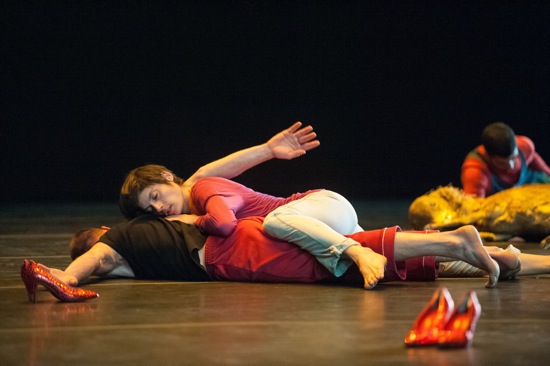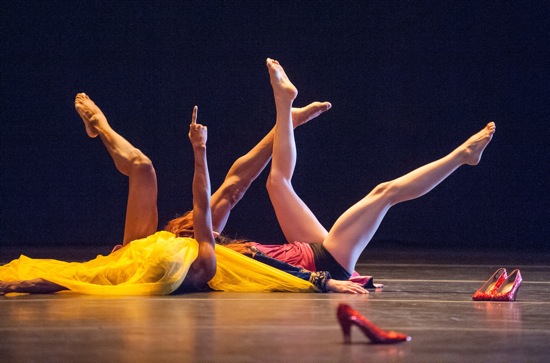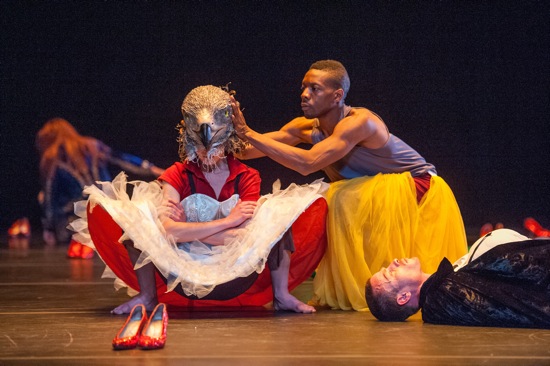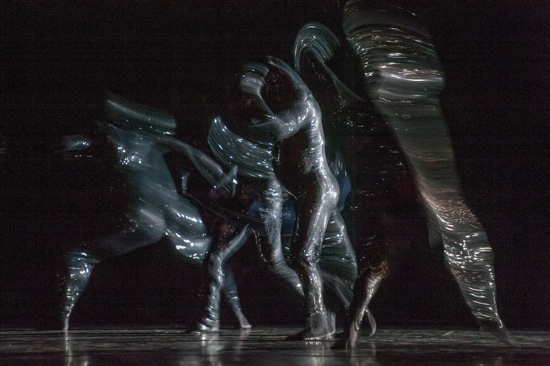The Lyon Opera Ballet brings Christian Rizzo’s ni fleurs, ni ford-mustang to BAM.

Julia Carnicer and Franck Laizet of the Lyon Opera Ballet in Christian Rizzo’s ni fleurs, ni ford-mustang. Photo: Stephanie Berger
The stage lights are dimming slowly— so slowly that we spectators can barely pin down the moment when we can no longer see the clump of seven dancers, covered head to toe in gleaming black outfits, wriggling and jouncing around. Nor can we be sure when the lights are truly out. There’s a nervous pause before people start to applaud, and in the moment before the clapping and the cheers achieve full volume, a voice from the audience calls out, “LET’S SEE YOU DANCE!”
Please forgive this brave person. After all, he (I believe it was a man) came to the BAM Howard Gilman Opera House to see a company called The Lyon Opera Ballet, and he may not have known that its director, Yorgos Loukos, has a reputation for presenting works by choreographers such as Lucinda Childs, Trisha Brown, William Forsythe, and Ohad Naharin, as well as obstreperous French postmodernists the likes of Jérôme Bel, Alain Buffard, and Christian Rizzo, whose ni fleurs, ni ford-mustang occasioned the outburst.
The work was one of the offerings in DANSE: A French-American Festival of Performances and Ideas, which continues in various theaters through May 18th. And not everyone in the audience may have boned up on “non-danse,” a phenomenon that appeared in France in the mid-1990s. bolstered by ideas drawn from philosophers such as Gilles Deleuze. The choreographers espousing non-danse didn’t not exactly follow Yvonne Rainer’s famous 1965 “No” Manifesto, except, for sure, her “No to virtuosity.” But “No to spectacle” and “No to transformations and magic and make-believe?” Instead, a resounding “Oui!”
Rizzo did not grow up in dance. He jumped into choreography from careers as a rock musician, a fashion designer,and a visual artist. ni fleurs, ni ford-mustang (2004) is an installation of sorts, in which seven human beings function as moving parts. The other parts include pairs of red high-heeled shoes scattered about; a hairy lump (what-is-it?) off to one side; a bar of large lights hanging at the back of the stage and aimed toward the audience; a gilded skeleton that descends from above, hangs above the non-dancing for a while, and eventually touches the floor and collapses. There are no flowers or Ford Mustangs in sight. The piece has been labeled “highly conceptual,” and words like “surreal” and “dream” have been attached to it.

Randy Castillo (L) and Julia Carnicer of the Lyon Opera Ballet in ni fleurs, ni ford-mustang. Photo: Stephanie Berger
Rizzo’s work has not gone un-attacked in France. A familiar metaphor has been seen in print: Hans Christan Anderson’s tale, “The Emperor’s New Clothes.” It takes a child calling out that the ruler on parade is naked for him and his anxious-to-seem-trendy subjects to acknowledge that his fine clothes are an illusion. The faces of some BAM spectators, as they rose from their seats and pulled on their coats, seemed to me to show as much bafflement as delight.
Minimalism started out being. . .well, minimal. Simple materials and few of them. Works of art that could be mistaken for ordinary objects, music that repeated the same brief motifs. Dances built of everyday movements. But this work of Rizzo’s suggests a desert island through which the dazed and shipwrecked wander, discovering offstage the odd, gaudy detritus that some long-ago theatrical company had discarded before dying of starvation.
It is not a friendly environment. The lighting (by Caty Olive ) tells us that. So does Gerome Nox’s electronic score that starts out as a barely heard industrial rumble and builds to almost ear-splitting volume before dying away, to return intermittently in new guises. A man walks onto the stage at a leisurely pace, picks a spot, and lies down. Seconds pass. A second person enters and lies down. After a while, seven bodies—some prone, some supine, one curled on its side—have joined the shoes as décor. More seconds pass. (What is that hairy lump?) One person rises, makes a decision, goes to a new place on the floor, and lies down. Another picks up on this idea. Finally all have chosen other locales. These are their names: Julia Carnicer, Randy Castillo, Simon Feltz, Franck Laizet, Elsa Monguillot de Mirman, Julian Nicosia, Ashley Wright.

(L to R): Elsa Monguillot de Mirman,, Randy Castillo, and Franck Laizet in Christian Rizzo’s 2004 work for the Lyon Opera Ballet. Photo: Stephanie Berger
As the piece progresses, various of them periodically leave the stage and return wearing bizarre outfits or half-outfits—a red tutu, a bird-head mask, a long white skirt, what could be a dusty, epauletted, 19th-century military jacket, etc. They also make wan contact with one another. Laizet, who has been lying on his face, stretches his butt up off the floor; Carnicer walks up to him and drapes herself over this small mountain peak; they collapse together. Two people rest their heads on a recumbent third person and take a little time out. A man drags a woman along the floor. Castillo carefully removes the seated Monguillot de Mirman’s bird-head. Sometimes, randomly, they point their fingers. Sometimes they all lie on their backs and stick their legs up. Behold: a little forest, small flags.
In this slow-moving dreamscape, just when I needed to be paying close attention in order to monitor changes, I fear that, for a few dangerous seconds, I entered a dream world of my own. As a result of this gaffe, I began to think that although Rizzo created ni fleurs, ni Ford-Mustang for an opera-house stage, I would like to see it from a closer vantage point—one that would make me feel like a not-so-spunky Alice-in-Wonderland, gazing here and there, deciding it best not to move if someone slithered across her foot. Maybe then I’d know what I discovered days later: the hairy lump represents a dead deer.

Members of the Lyon Opera Ballet at the climax of Christian Rizzo’s ni fleurs, ni ford-mustang. Photo: Stephanie Berger
Rizzo builds the stage picture savvily in terms of design, speed, and density, but in this deliberately paced work, speed doesn’t mean fast. The most sudden move I saw was the skeleton’s final crumple. That, and the taking away of the shoes come near the end of ni fleur, ni ford-mustang’s 50-minute duration. The climax builds gradually, with just one performer re-entering in one of the ghoulish black outfits that manage to be both form-fitting and slightly baggy. Little sparkly bits on them catch the light. Pretty soon there are two performers dressed like this, then three, then all.
The dance party they’ve come for happens upstage in dim light. Milling around, thrashing, picking up their feet, kicking out, they’ve arrived too late. If this is a party, the food and drinks have run out, and the musicians are packing up. Never mind, these gifted performers in heavy disguise keep dancing as their shred of a world goes dark.
